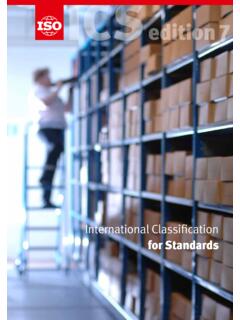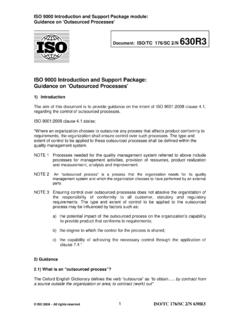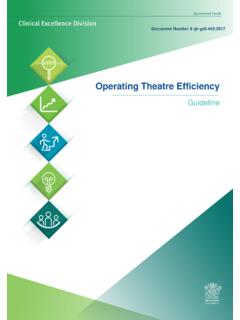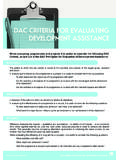Transcription of Quality management principles
1 QualityQuality management principlesThis document introduces seven Quality management principles (QMPs). ISO 9000, ISO 9001 and related ISO Quality management standards are based on these seven of the definitions of a principle is that it is a basic belief, theory or rule that has a major influence on the way in which something is done. Quality management principles are a set of fundamental beliefs, norms, rules and values that are accepted as true and can be used as a basis for Quality QMPs can be used as a foundation to guide an organization s performance improvement. They were developed and updated by international experts of ISO/TC 176, which is responsible for developing and maintaining ISO s Quality management document provides for each QMP : Statement : Description of the principle Rationale : Explanation of why the principle is important for the organization Key benefits : Examples of benefits associated with the principle Actions you can take : Examples of typical actions to improve the organization s performance when applying the principleThe seven Quality management principles are :QMP 1 Customer focusQMP 2 LeadershipQMP 3 Engagement of peopleQMP 4 Process approachQMP 5 ImprovementQMP 6 Evidence-based decision makingQMP 7 Relationship managementThese principles are not listed in priority order.
2 The relative importance of each principle will vary from organization to organization and can be expected to change over Customer focusStatementThe primary focus of Quality management is to meet customer requirements and to strive to exceed customer success is achieved when an organization attracts and retains the confidence of customers and other interested parties. Every aspect of customer interaction provides an opportunity to create more value for the cus-tomer. Understanding current and future needs of customers and other interested parties contributes to sustained success of the benefits Increased customer value Increased customer satisfaction Improved customer loyalty Enhanced repeat business Enhanced reputation of the organization Expanded customer base Increased revenue and market share2 Actions you can take Recognize direct and indirect customers as those who receive value from the organization. Understand customers current and future needs and expectations.
3 Link the organization s objectives to customer needs and expectations. Communicate customer needs and expectations throughout the organization. Plan, design, develop, produce, deliver and support goods and services to meet customer needs and expectations. Measure and monitor customer satisfaction and take appropriate actions. Determine and take actions on interested parties needs and expectations that can affect customer satisfaction. Actively manage relationships with customers to achieve sustained LeadershipStatementLeaders at all levels establish unity of pur-pose and direction and create conditions in which people are engaged in achieving the organization s Quality of unity of purpose and direc-tion and engagement of people enable an organization to align its strategies, policies, processes and resources to achieve its benefits Increased effectiveness and efficiency in meeting the organization s Quality objectives Better coordination of the organization s processes Improved communication between levels and functions of the organization Development and improvement of the capability of the organization and its people to deliver desired resultsActions you can take Communicate the organization s mission, vision, strategy, policies and processes throughout the organization.
4 Create and sustain shared values, fairness and ethical models for behaviour at all levels of the organization. Establish a culture of trust and integrity. Encourage an organization-wide commitment to Quality . Ensure that leaders at all levels are positive examples to people in the organization. Provide people with the required resources, training and authority to act with accountability. Inspire, encourage and recognize people s Engagement of peopleStatementCompetent, empowered and engaged people at all levels throughout the organization are essential to enhance its capability to create and deliver manage an organization effectively and efficiently, it is important to involve all people at all levels and to respect them as individuals. Recognition, empowerment and enhancement of competence facilitate the engagement of people in achieving the organization s Quality benefits Improved understanding of the organization s Quality objectives by people in the organization and increased motivation to achieve them Enhanced involvement of people in improvement activities Enhanced personal development, initiatives and creativity Enhanced people satisfaction Enhanced trust and collaboration throughout the organization Increased attention to shared values and culture throughout the organizationActions you can take Communicate with people to promote understanding of the importance of their individual contribution.
5 Promote collaboration throughout the organization. Facilitate open discussion and sharing of knowledge and experience. Empower people to determine constraints to performance and to take initiatives without fear. Recognize and acknowledge people s contribution, learning and improvement. Enable self-evaluation of performance against personal objectives. Conduct surveys to assess people s satisfaction, communicate the results, and take appropriate Process approachStatementConsistent and predictable results are achieved more effectively and efficiently when activities are understood and managed as interrelated processes that function as a coherent Quality management system consists of inter-related processes. Understanding how results are produced by this system enables an organization to optimize the system and its benefits Enhanced ability to focus effort on key processes and opportunities for improvement Consistent and predictable outcomes through a system of aligned processes Optimized performance through effective process management , efficient use of resources, and reduced cross-functional barriers Enabling the organization to provide confidence to interested parties as to its consistency, effectiveness and efficiency8 Actions you can take Define objectives of the system and processes necessary to achieve them.
6 Establish authority, responsibility and accountability for managing processes. Understand the organization s capabilities and determine resource constraints prior to action. Determine process interdependencies and analyse the effect of modifications to individual processes on the system as a whole. Manage processes and their interrelations as a system to achieve the organization s Quality objectives effectively and efficiently. Ensure the necessary information is available to operate and improve the processes and to monitor, analyse and evaluate the performance of the overall system. Manage risks that can affect outputs of the processes and overall outcomes of the Quality management ImprovementStatementSuccessful organizations have an ongoing focus on is essential for an organization to maintain current levels of performance, to react to changes in its internal and external conditions and to create new benefits Improved process performance, organizational capabilities and customer satisfaction Enhanced focus on root-cause investigation and determination, followed by prevention and corrective actions Enhanced ability to anticipate and react to internal and external risks and opportunities Enhanced consideration of both incremental and breakthrough improvement Improved use of learning for improvement Enhanced drive for innovationActions you can take Promote establishment of improvement objectives at all levels of the organization.
7 Educate and train people at all levels on how to apply basic tools and methodologies to achieve improvement objectives. Ensure people are competent to successfully promote and complete improvement projects. Develop and deploy processes to implement improvement projects throughout the organization. Track, review and audit the planning, implementation, completion and results of improvement projects. Integrate improvement considerations into the development of new or modified goods, services and processes. Recognize and acknowledge Evidence-based decision makingStatementDecisions based on the analysis and evaluation of data and information are more likely to produce desired making can be a complex process, and it always involves some uncertainty. It often involves multiple types and sources of inputs, as well as their interpretation, which can be subjective. It is important to understand cause-and-effect relationships and potential unintended consequences. Facts, evidence and data analysis lead to greater objectivity and confidence in decision benefits Improved decision-making processes Improved assessment of process performance and ability to achieve objectives Improved operational effectiveness and efficiency Increased ability to review, challenge and change opinions and decisions Increased ability to demonstrate the effectiveness of past decisions12 Actions you can take Determine, measure and monitor key indicators to demonstrate the organization s performance.
8 Make all data needed available to the relevant people. Ensure that data and information are sufficiently accurate, reliable and secure. Analyse and evaluate data and information using suitable methods. Ensure people are competent to analyse and evaluate data as needed. Make decisions and take actions based on evidence, balanced with experience and Relationship managementStatementFor sustained success, an organization manages its relationships with interested parties, such as parties influence the performance of an organ-ization. Sustained success is more likely to be achieved when the organization manages relationships with all of its interested parties to optimize their impact on its performance. Relationship management with its sup-plier and partner networks is of particular benefits Enhanced performance of the organization and its interested parties through responding to the opportunities and constraints related to each interested party Common understanding of goals and values among interested parties Increased capability to create value for interested parties by sharing resources and competence and managing Quality -related risks A well-managed supply chain that provides a stable flow of goods and servicesActions you can take Determine relevant interested parties (such as suppliers, partners, customers, investors, employees, and society as a whole) and their relationship with the organization.
9 Determine and prioritize interested party relationships that need to be managed. Establish relationships that balance short-term gains with long-term considerations. Pool and share information, expertise and resources with relevant interested parties. Measure performance and provide performance feedback to interested parties, as appropriate, to enhance improvement initiatives. Establish collaborative development and improvement activities with suppliers, partners and other interested parties. Encourage and recognize improvements and achievements by suppliers and next stepThis document provides a general perspective on the Quality management principles underlying ISO s Quality management standards. It gives an overview of these principles and shows how, collectively, they can form a basis for performance improvement and organizational are many different ways of applying these Quality management principles . The nature of the organization and the specific challenges it faces will determine how to implement them.
10 Many organizations will find it beneficial to set up a Quality management system based on these information on ISO 9000, ISO 9001 and related ISO Quality management standards is available from ISO s national member bodies or from the Organization for StandardizationISO Central Secretariat Chemin de Blandonnet 8 Case Postale 401 CH 1214 Vernier, Geneva ISO, 2015 All rights reserved ISBN 978-92-67-10650-2


















